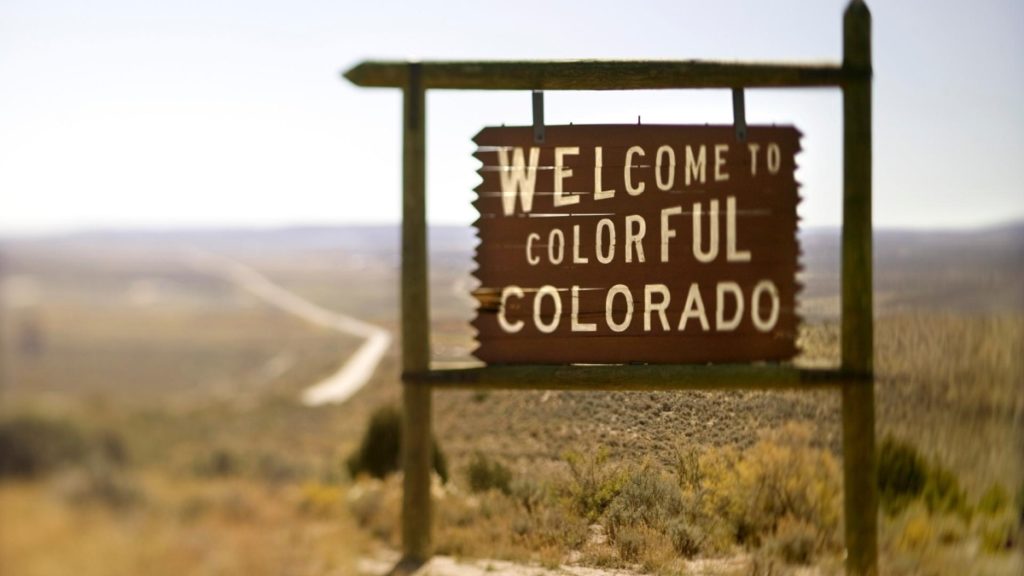
Living or visiting Colorado and wondering what bird you’re looking at? This article covers the most common birds of Colorado. Odds are high the bird you’re looking at is one of them. It will also inform you on how to identify them.
Colorado is among the top ten best states for birding. Five specific locations are special favorites among birders.
- Barr Lake in Adams County is where the Rocky Mountain Bird Observatory, as well as 350 different species of birds, can be found.
- The Cherry Creek Reservoir in Arapahoe County is a prime Colorado birding site from summer through spring throughout the winter. The southern part of the lake is home to shorebirds. During the summer, the reservoir is where the Yellow-breasted Chat and the Yellow Warbler come to breed.
- Birders come to the Monte Vista National Wildlife Refuge in Rio Grande County for the Sandhill Crane migration during the spring and fall. There is a crane festival every March as well as tours through San Luis Valley.
- Huerfano County has more than a hundred species of birds, and the spring months of April through June are the time for spotting them. The town of La Veta is a great place for finding bald eagles during the winter, turkey vultures, ravens, hummingbirds, downy woodpeckers, and great-horned owls.
- Crow Valley Campground in Weld County has trees and water and is a popular migrating bird destination. The campground can fill with warblers, Common Redpoll, thrushes, and flycatchers. In the winter, the Long-eared owls may come to roost. There are excellent birding trails in the southern part of the campground. The northern trails may lead to the White-faced Ibis and other wading birds.
Colorado’s Most Common Birds
Lark Bunting

The Lark Bunting is Colorado’s state bird and an excellent representative of this beautiful state. This sparrow has a compact body and a large, conical bill. It grows 5.5 to 7.1 inches in length, weighs 1.3 to 1.5 ounces with a wingspan of 9.8 to 11.0 inches.
This regal-looking bird is black with elegant white patches on its wings and has a light blue bill. The female is more brownish, with brown belly streaks. They forage for food on open ground and grassland and feed on insects and seeds.
Brown-capped Rosy Finch
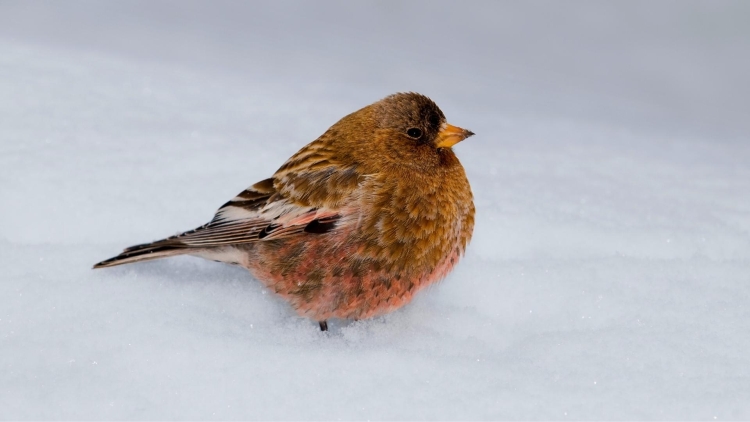
The Brown-capped Rosy Finch lives mostly in the Rockies, especially in Colorado.
This is a small songbird with a long and forked tail and a short, conical dark bill that turns yellow during the non-breeding season. They grow between. 5.5 to 6.3 inches in length, weigh 0.8 to 1.2 ounces with a wingspan of 13 inches.
The male has brown plumage with a gray cap and a noticeable pink underbelly and rump. The female is a duller shade of brown. The Brown-capped Rosy Finch feeds on seed and insects snapped out of the snow.
Belted Kingfisher

The Belted Kingfisher is a stocky bird with a short, square tail. The head is large with a shaggy crest, giving them a kind of unkempt “bed-hair” appearance. They grow between 11.0 and 13.8 inches, weigh between 4.9 and 6.0 ounces with a wingspan between 18.l9 and 22.8. Their top is bluish-gray with white marks on the wings and underbelly and around the throat. A rarity in the aviary world, the female is more colorful, with a rust-colored patch around the belly that the male lacks.
They spend their time near streams, rivers, and lakes in search of fish and crustaceans to catch. Their diet also includes berries and small mammals. They nest close to the water and can be found in Colorado year-round.
Black-capped Chickadee
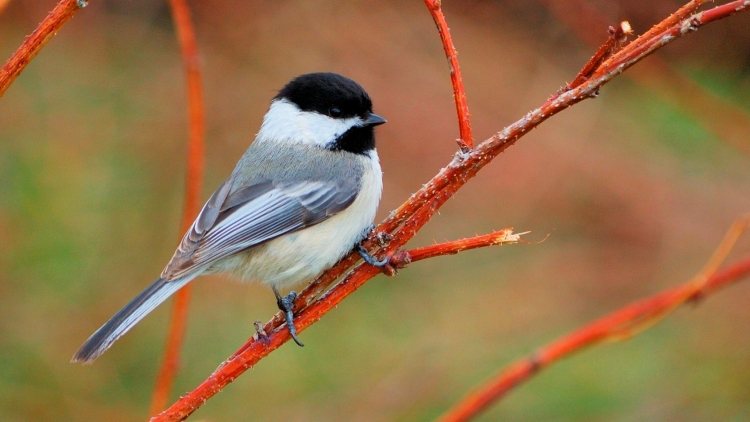
The Black-capped Chickadee are small birds with short, thin bills. Their head and bib are black, with white cheeks and white and dark-gray striped wings. The underbelly is solid white. They grow between 4.5 and 5.5 in length and weigh between 0.3 and 0.4 ounces. In Colorado, they can be found at an altitude of 5,000 and 9,000 feet in deciduous forests and some urban areas.
They feed mainly on insects in the summer and forage for seeds and berries in the winter. They will visit bird feeders for sunflower seeds, peanut butter, suet, and mealworms.
Golden Eagle

In Colorado, the majestic Golden Eagle can be found year-round in Mueller State Park, Lake Pueblo State Park, and Cheyenne Mountain State Pak, as well as the Colorado Springs area. They grow between 27.6 and 33.1 inches, weigh between 105.8 and 216.1 ounces with a wingspan of 72.8 and 86.6 inches. Surprisingly, the female is larger than the male. The body is brown, with a golden neck from which it gets its name. Their beak has a dramatic hook that is golden near the face.
They nest in tall trees and steep slopes. Their wide wingspan allows them to soar like few other birds, reaching speeds of 200 miles per hour. They pursue their prey and can spot a mouse’s whiskers from a distance of two miles. They will pursue deer, squirrels, coyotes, livestock, and rabbits. Birders who catch a Golden Eagle in flight are fortunate, indeed.
Common Birds of Colorado by Color
Black Birds in California
Mountain Chickadee
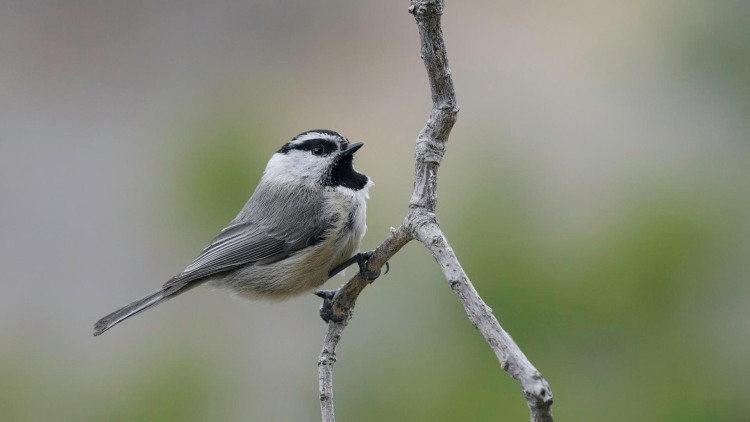
The Mountain Chickadee can be spotted in Colorado year-round, mostly in the western and south-central areas of the state. They are small birds with a black and white head and a gray body. They grow between 4.3 to 5.5 inches and weigh 0.4 ounces with a wingspan of 7.5 inches. They inhabit coniferous forests and perch high up and may not be easy to find. The Mountain Chickadee feeds on insects and seeds.
American White Pelican
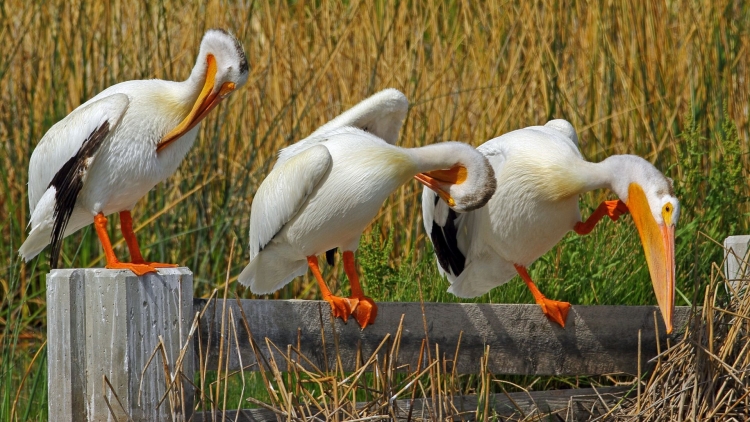
The American White Pelican is a surprise in the mountains of Colorado. However, they inhabit the lake areas and central Colorado in Antero Reservoir in Park County, McFarlane Reservoir in Jackson County, and Riverside Reservoir in Weld County. Birders have the choice of plenty of trails, such as Headwaters Trail, Pronghorn Trail, Snow Goose Trail, White Water Trail, and others.
This Pelican is large, 50 to 70 inches long with a wingspan up to 9 feet. They are white with black wingtips and spectacular contract black under-feathers with orange webbed feet. They are master divers and will bomb-dive into the water for fish.
Black-necked Stilt
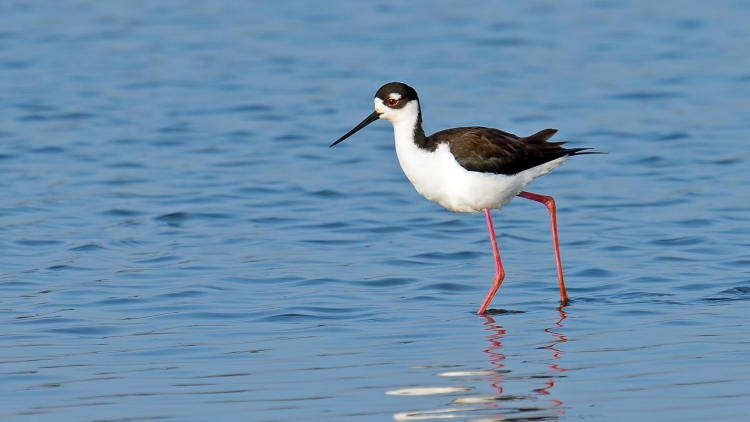
The Black-necked Stilt A tall but small-bodied shorebird with very long legs, a long neck, a small head, and a thin, straight bill that can be spotted in Colorado’s El Paso County and Pikes Peak County. They are another Colorado bird with a spectacular black and white contrasting body – the head and wings are glossy black while the front part of the neck and belly are white. Their long legs are pink.
The Black-necked Stilt is delicate-looking, with a short body being held up by very long legs. They grow 13.8 to 15.3 inches long, weigh between 5.3 and 6.2 ounces with a wingspan of 28.1 to 29.7 inches. The females are more brown than black.
They spend their time in shallow water looking for marine invertebrates and insects.
Blue Birds in Colorado
Barn Swallow
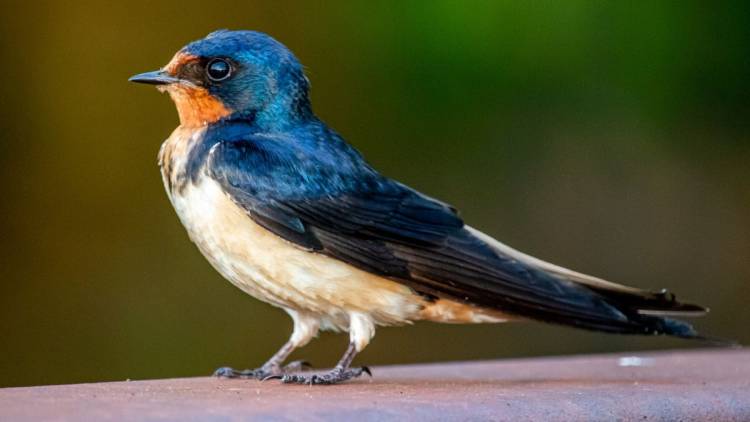
The Barn Swallow has a flattened head with no visible neck and long, pointed wings. The very long tail has a deep fork, the only forked tail on any U.S. swallow. They have a blue crown and back with a cinnamon throat and belly. The Barn Swallow grows 5.9 to 7.5 inches long, weighs 0.6 to 0.7 ounces with a wingspan between 11.4 and 12.6 inches.
Blue Grosbeak

The Blue Grosbeak is stocky with a very triangular bill. The male is a deep blue and a black eye mask, and a black and silver beak that covers a good part of its face, and brownish wing bars. The female is more cinnamon-brown in color, with some blue hues in the tail. They grow between 5.9 and 6.3 inches, weigh 0.9 to 1.1 ounces with a wingspan of 11.0 inches.
They inhabit shrubby areas with only a few trees, and their diet consists of insects and seeds and some waste grain.
Pinyon Jay
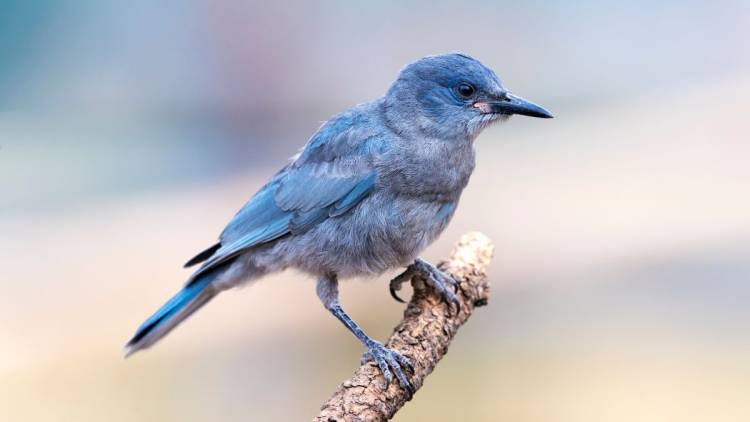
The Pinyon Jay is a medium-sized bird with a shorter tail and longer bill than most jays. It grows between 10.2 and 11.4 inches in length, weighs 3.2 to 4.2 ounces with a wingspan of 18.1 inches.
Both the male and female are almost entirely blue with a bluish-gray belly and a white patch on the throat. They feed on pinyon pine seeds but will also eat snakes and other small animals and will visit a feed feeder for peanuts, sunflower seeds, and suet. They are social creatures and usually are a part of a large flock.
Red Birds in Colorado
American Robin

The American Robin is a large songbird with a round body, long tail, and long legs. They grow to 7.9 and 11.0 inches in length, weigh 2.7 and 3.0 ounces with a wingspan between 12.2 and 15.8 inches. They have a light gray head and wings and a lovely orange belly with a white patch. The female is a bit paler.
They used to flee the Colorado winter and fly south, but they are now spending their time year-round in the state and can be seen in parks, on golf courses, fields, and pastures, as well as deciduous and pine forests. Their main diet is berries, especially fermented blackberries or juniper berries, and they have been known to become stumbling tipsy. A few seeds will work to sober them up.
Pine Grosbeak
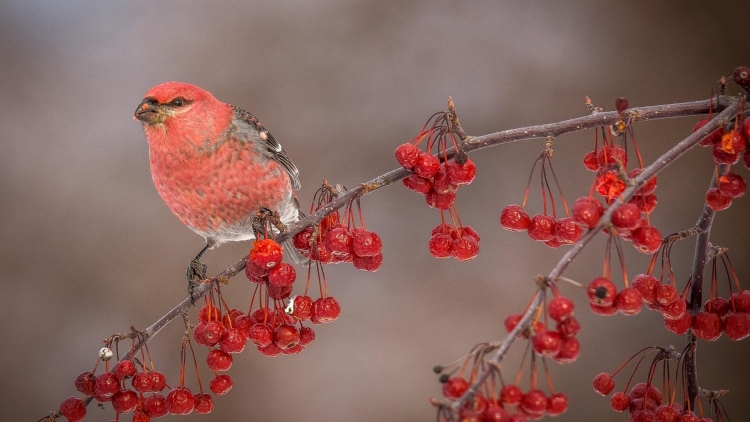
In Colorado, the Pine Grosbeak can be found around open pine forests. They grow between 7.9 and 9.8 inches and weigh from 1.8 and 2.8 ounces. The Pine Grosbeak has a gray tail, gray wings with white stripes, and a stunning rosy/red head and body. The female has more gray tints.
They inhabit pine trees and eat the needles or fallen seeds. They search for fruits and more seeds during the winter.
Pine Grosbeaks frequently visit feeders, especially during the winter.
Red Crossbill
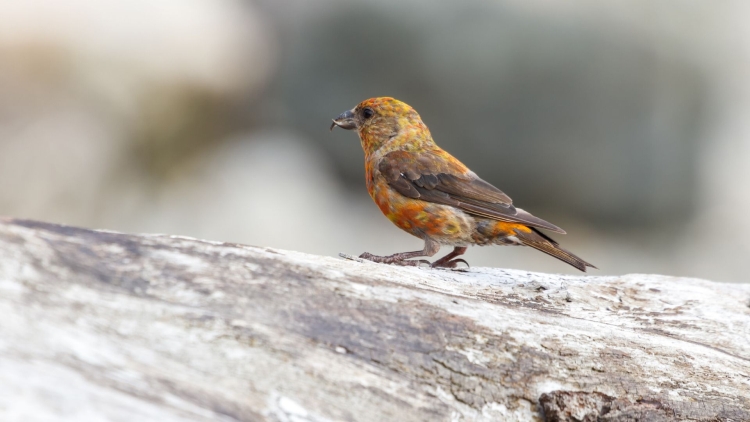
The Red Crossbill is unique in that the bill is criss-cross like crossed human fingers. They grow to 5.5 to 7.5 inches, weigh 1.4 ounces with a wingspan of 10.11 inches. These birds are stocky and have large heads and thick neck. The male is a bright red with brownish wings, while the female has a greenish tint. Both males and females have black eyes and black legs.
They live in coniferous forests and rely heavily on conifer seeds for their diet, which they even feed their young.
Orange Birds in Colorado
Red Breasted Nuthatch

The Red Breasted Nuthatch is a small bird with a pointed bill and a short tail. They grow up to 4.3 inches in length and weigh 0.3 to 0.5 ounces with a wingspan of 7.1 to 7.9 inches. Their wings and the upper part is a light blue-gray, while the underbelly is a rusty orange (not red, as the name implies). The female is the same color but looks duller and more washed out. Both males and females have a white stripe over their eyes.
The Red Breasted Nuthatch inhabits coniferous forests and deciduous trees and lives year-round in the northern and eastern parts of Colorado. They feed on insects and seeds while adding spiders to their summer diet.
Bullock’s Oriole
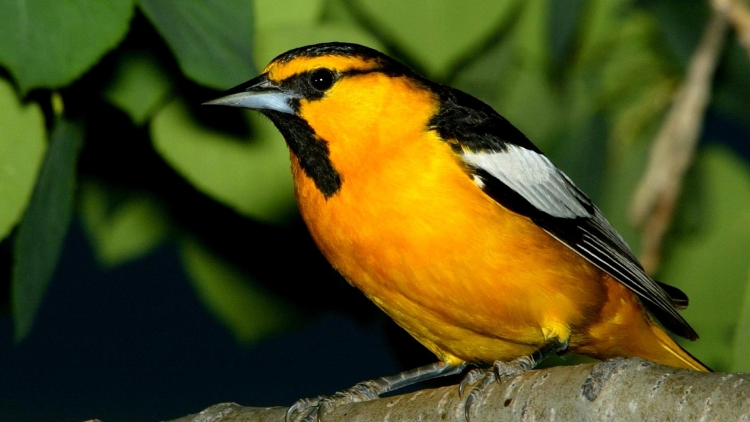
The Bullock’s Oriole is a medium-sized bird with a long tail. The males have an orange face with a black patch down the neck, a black tail, and black and white striped wings. They grow from 6.7 to 7.5 inches and weigh 1.0 to 1.5 ounces with a wingspan of 12.2 inches.
The Bullock’s Orioles lives in woodland near streams, cottonwood trees, as well as parks, and orchard. They feed on caterpillars, other insects, and fruit, and will visit backyards for sugar water.
Spotted Towhee
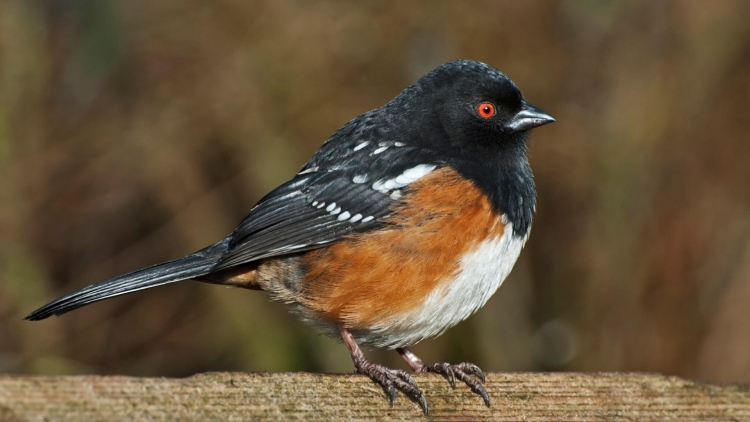
The Spotted Towhee has a sturdy body with a short neck and long, round tail. Its face, wings, and throat are pure black, while the wings are spotted with white. The female is grayish brown while the male is black. The underbelly on both is orange. They grow 6.7 to 8.3 inches in length and weigh 1.2 to 1.7 ounces with a wingspan of 11.0 inches.
They inhabit open shrubby areas with thick undergrowth, or they may live by the edge of forests and fields. They feed on insects and fruits. They live in southern and southwestern Colorado all year.
Black Headed Grosbeak
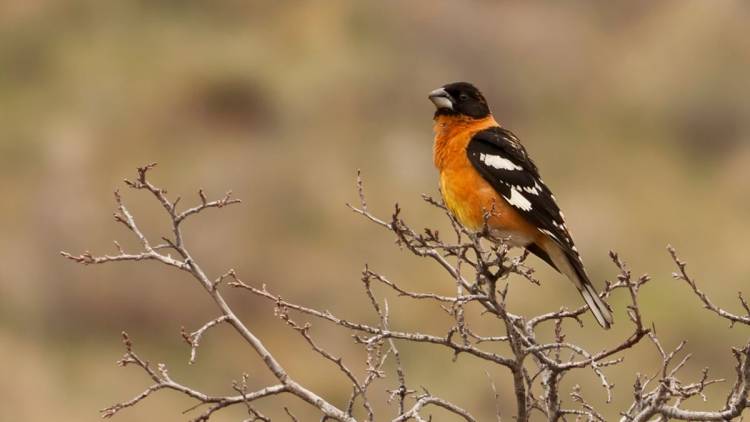
The Black Headed Grosbeak enjoys a high altitude of between 5,000 and 8,000 feet in Rocky Mountain National Park, as well as woodlands near rivers. They grow 7.5 inches long and weigh 1.7 ounces with a wingspan of 12.6 inches. They have an overall orange body with a black head and black and white wings and a thick beak. The female is paler. They feed on insects, seeds, and berries.
Yellow Birds in Colorado
American Goldfinch

The American Goldfinch is short with a small head, a short tail, and long wings. Male and female grow to 4.3 and 5.1 inches in length, weigh 0.4 to 0.7 ounces and have a wingspan between 7.5 and 8.7 inches. The male is a vivid yellow and has a black forehead and black wings with light markings. There are white markings above and beneath the tail. The female is more yellow than white, and olive on top.
They mostly inhabit fields and floodplains with thistles and asters. They can also be found in orchards and backyards, especially during the winter. Grains such as sunflower seeds and elm seeds make up the majority of their diet.
Wilson’s Warbler
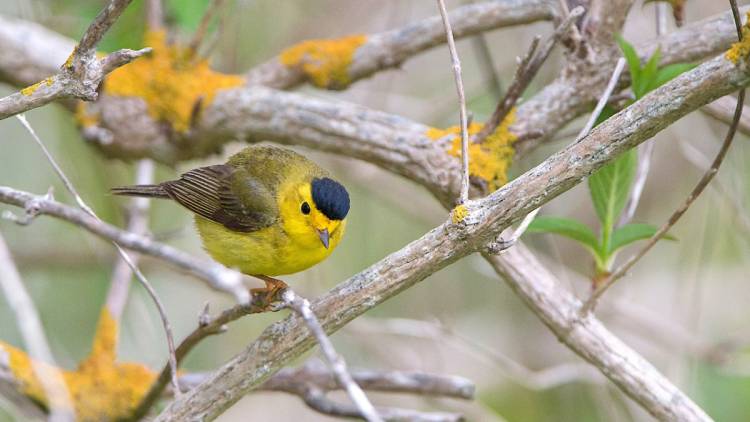
The Indian Peaks Wilderness Area is one of the sites where birders can spot the Wilson’s Warbler in Colorado. They are a small warbler with a long tail and a thin bill, with a very round body and large head. They are a bright yellow below and a bit more olive-hued above, with black eyes and a black cap on top of their head, although the female just has a small black spot. The black cap looks incongruous enough on the yellow head to seem like fake hair. They grow 3.9 to 4.7 inches in length, weigh 0.2 to 0.3 ounces, with a wingspan between 5.5 to 6.7 inches.
They avoid dense forests but inhabit mountainous terrain near streams and lakes and search for insects among the leaves.
Yellow-Breasted Chat
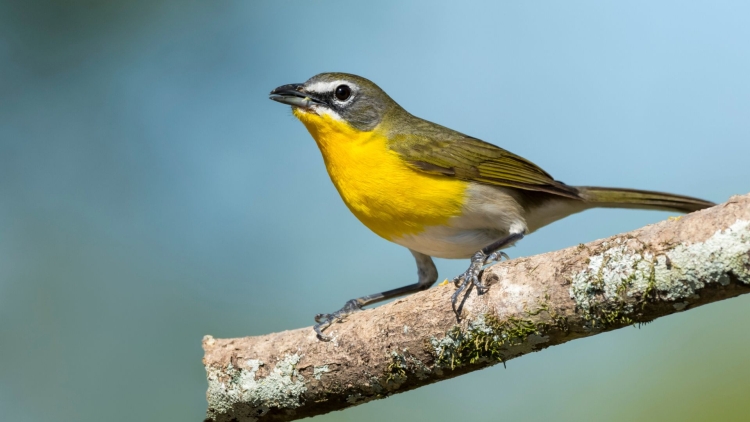
The Yellow-breasted Chat is bulky with a long tail and thick bill. Their wings and tail are olive-green while their breast is bright yellow with a white belly. The face has white marking around the eyes giving the appearance of the Chat wearing glasses.
They grow to 7.1 inches in length, weight 0.8 to 1.1 ounces and have a wingspan of 9.8 inches.
They inhabit dense, shrubby areas and feed on insects and larvae from low-lying branches. The Chat remains well-hidden throughout the year but may be seen and heard in the Spring.
Common Birds of Colorado by Species
Woodpeckers in Colorado
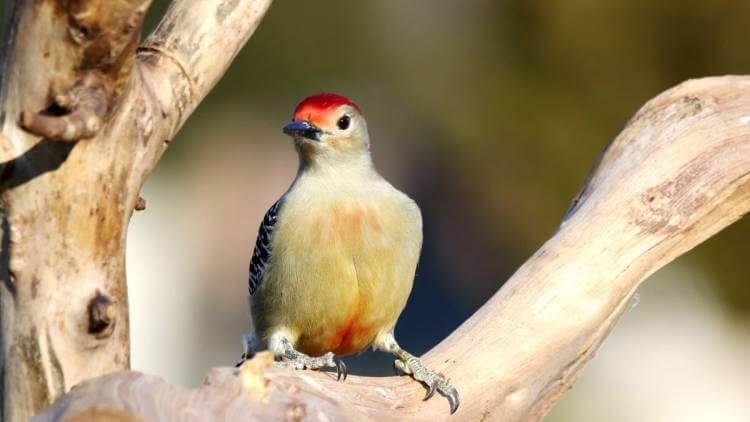
Red-bellied Woodpecker – Melanerpes carolinus – can be spotted in northeastern Colorado. Contrary to their name, it is their head that is red. Their stomach is a very pale shade of barely noticeable red. Their wings are almost perfectly striped black and white. They grow 9.4 inches in length, weigh 2.0 to 3.2 ounces with a wingspan of 13.0 to 16.5 inches. They feed on insects and berries and will keep live insects for a future meal.
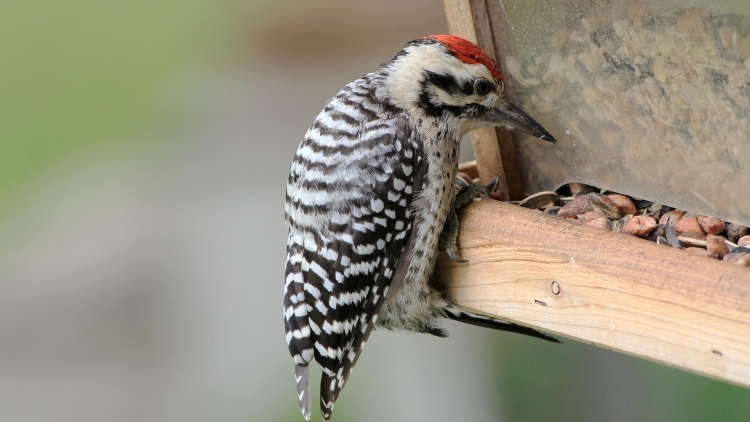
Ladder-backed Woodpecker – Dryobates scalaris – can be found in southeastern Colorado all year, but the optimum time to spot them is between January and March. They like dry scrublands and thorn forests where they feed on insects and insect larvae. The Ladder-back Woodpecker grows 6.3 to 7.1 inches, weighs 0.7 to 1.7 ounces with a wingspan of 13.0 inches.
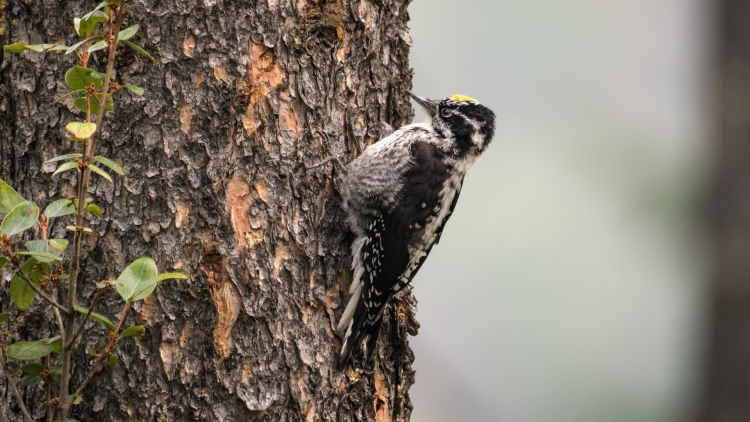
American Three-Toed Woodpecker – Picoides dorsalis – Northwest Colorado, especially the Rocky Mountains, is one of the rare places where this woodpecker can be spotted. They prefer living in old trees for the insect larvae they find there. Their three toes allow them to lean back and strike hard at a target. They grow from 8.3 to 9.2 inches in length, weigh 1.6 to 2.4 ounces with a wingspan of 14.6 to 15.3 inches.
Warblers in Colorado
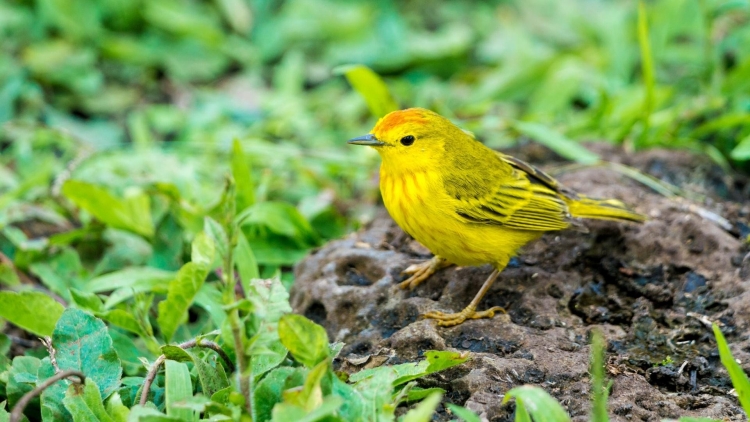
American Yellow Warbler – Setophaga petechia – grows between 3.9 and 7.1 inches long and weigh from .25 to .88 ounces. Their entire body is yellow, with just a few tanned streaks on the chest. Males are a more vibrant shade of yellow than the females. They live in forests, especially along wetlands. They feed on insects such as caterpillars, beetles, and wasps.
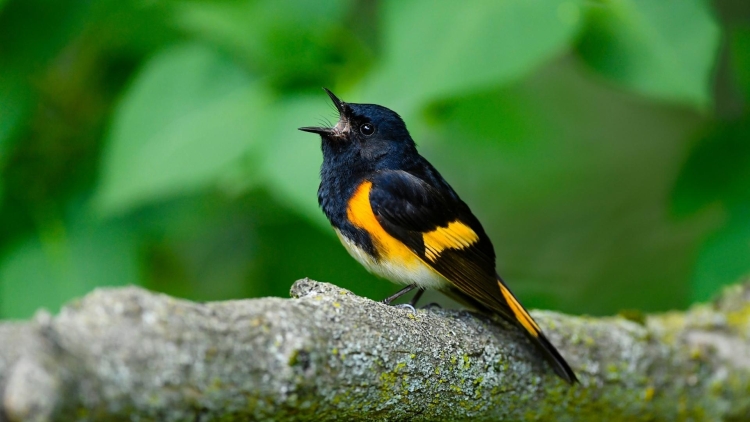
American Redstart – Setophaga ruticilla – the male is a striking black with red/orange patches on the sides, wings, and tail. The female is a shade of gray with yellowish patches rather than bright red. The American Redstart grows to a length of 4.3 to 5.1 inches, weighs 0.2 to 0.3 ounces with a wingspan of 6.3 to 7.5 inches. They inhabit deciduous forests and feed off insects.
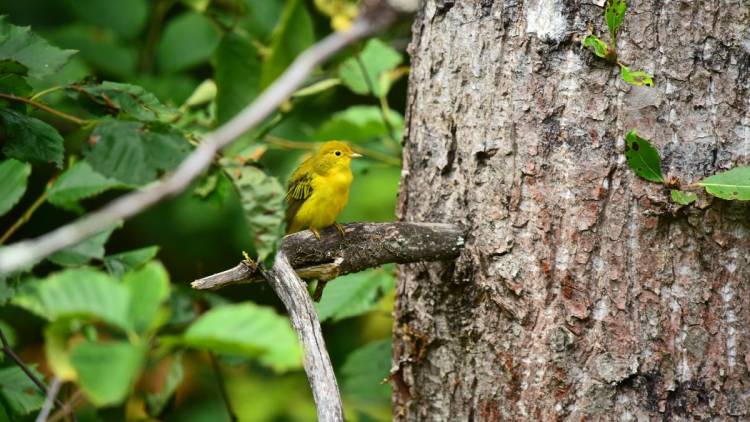
Orange-Crowned Warbler – Leiothlypis celata – is a shade of olive/yellow, with a black line through the eye and a white strip over the eye. The orange head patch after which they are named is actually hidden until they raise their head feathers. The undertail is a vibrant yellow. They grow between 4.3 to 5.5 inches in length, weigh 0.3 to 0.4 ounces with a wingspan of 7.5 inches.
They inhabit dense shrubs and will feed on insects and berries and tree nectar. They will visit bird feeders for suet and peanut butter.
Hawks in Colorado
Hawks can frequently be seen in Colorado Dinosaur Ridge.
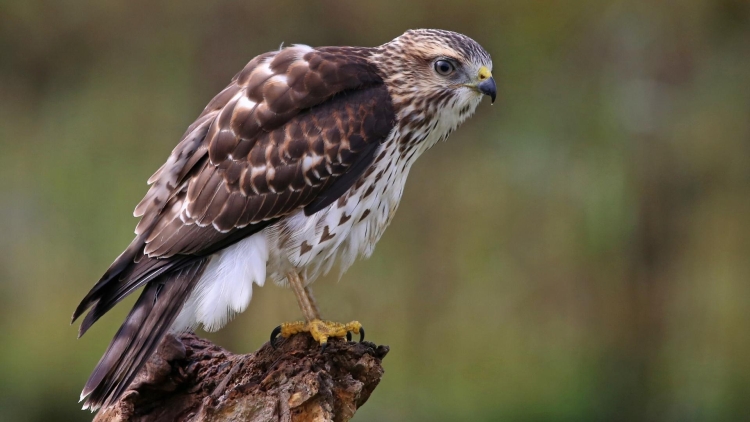
Broad-winged Hawk – buteo platypterus – is a small hawk with a chunky body, a large head, and a short and square tail. They grow between 13.4 to 17.3 inches, weigh 9.3 to 9.8 ounces with a wingspan between 31.9 and 39.4 inches. They have a brown head, black and white strips on the tail, and a barred underbelly. They perch high up in forest canopies waiting for unsuspecting small mammals.

Ferruginous Hawk – buteo regalis – can be spotted in the Rocky’s Arsenal National Wildlife Refuge. This beautiful, majestic large raptor is the largest buteo hawk and has been mistaken for an eagle. They have a rusty-brown back and shoulder with a paler head and a white tail tinted with rust. The long wings are brown with white feathers below.
The Ferruginous Hawk grows between 20 to 27 inches, weighs 32.0 to 80.0 ounces with a wingspan between 48 to 60 inches. They inhabit dry grassland and open country and prey on small mammals such as squirrels, gophers, mice, or rabbits.
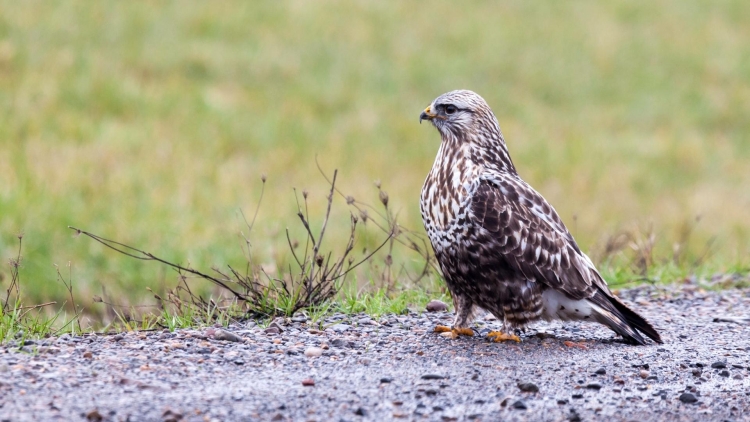
Rough-legged Hawk – Buteo lagopus – These hawks are brown with a spotted white throat and a brown tail that is paler at the base. Some Rough-legged Hawks have a pale underwing with dark spots while others have a darker brown underwing. They grow to 18.5 to 20.5 inches in length, weigh 25.2 to 49. 4 ounces with a wingspan of 52.0 to 54.3 inches. They are in Colorado during the winter, when they perch up on trees or utility poles waiting for their prey.
Further Reading on Colorado Birding
For more information on birding in Colorado, consider the following guidebooks:
- Tekiela, Stan (Author)
- English (Publication Language)
- Floyd, Ted (Author)
- English (Publication Language)
These websites may also provide additional information:


